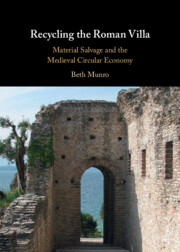125 results
2 - Circular Cities
- from Part II - Circular Carbon Economy and Pathway Frameworks
-
-
- Book:
- Carbon Neutrality in the Gulf
- Published online:
- 02 January 2025
- Print publication:
- 16 January 2025, pp 11-29
-
- Chapter
- Export citation
Addressing the toxic chemicals problem in plastics recycling
-
- Journal:
- Cambridge Prisms: Plastics / Volume 3 / 2025
- Published online by Cambridge University Press:
- 16 January 2025, e3
-
- Article
-
- You have access
- Open access
- HTML
- Export citation
6 - E-Waste Burning
- from Part II - Pathways and Predicaments
-
- Book:
- Polluted Politics
- Published online:
- 18 December 2024
- Print publication:
- 05 December 2024, pp 135-158
-
- Chapter
- Export citation
2 - The West Line E-Waste Economy
- from Part I - Positioning E-Waste Hubs
-
- Book:
- Polluted Politics
- Published online:
- 18 December 2024
- Print publication:
- 05 December 2024, pp 33-60
-
- Chapter
- Export citation
Reboundless design: towards the prevention of rebound effects by design
- Part of
-
- Journal:
- Design Science / Volume 10 / 2024
- Published online by Cambridge University Press:
- 05 December 2024, e42
-
- Article
-
- You have access
- Open access
- HTML
- Export citation
Pioneering the Circular Economy: Small and Medium-Sized Recycling Enterprises in Finland, 1945–1995
-
- Journal:
- Business History Review / Volume 98 / Issue 4 / Winter 2024
- Published online by Cambridge University Press:
- 14 April 2025, pp. 793-819
- Print publication:
- Winter 2024
-
- Article
- Export citation
4 - Designing Technology
-
- Book:
- Reimagining Prosperity
- Published online:
- 18 October 2024
- Print publication:
- 21 November 2024, pp 112-138
-
- Chapter
-
- You have access
- Open access
- HTML
- Export citation
The contribution of global waste picker organizations in responding to the plastic pollution crisis
-
- Journal:
- Cambridge Prisms: Plastics / Volume 2 / 2024
- Published online by Cambridge University Press:
- 11 November 2024, e29
-
- Article
-
- You have access
- Open access
- HTML
- Export citation

Recycling the Roman Villa
- Material Salvage and the Medieval Circular Economy
-
- Published online:
- 08 November 2024
- Print publication:
- 31 October 2024
Sustainability and SMEs: Opening the black box
-
- Journal:
- Journal of Management & Organization / Volume 30 / Issue 3 / May 2024
- Published online by Cambridge University Press:
- 21 October 2024, pp. 413-420
-
- Article
-
- You have access
- HTML
- Export citation
The Zero Draft Plastics Treaty: Gaps and challenges
-
- Journal:
- Cambridge Prisms: Plastics / Volume 2 / 2024
- Published online by Cambridge University Press:
- 08 October 2024, e24
-
- Article
-
- You have access
- Open access
- HTML
- Export citation
Design issues concerning circular economy assessment methods at the product level: a comparative analysis through a case study of a mobile tiny house
- Part of
-
- Journal:
- Design Science / Volume 10 / 2024
- Published online by Cambridge University Press:
- 05 June 2024, e12
-
- Article
-
- You have access
- Open access
- HTML
- Export citation
Surveying factors that influence healthcare personnel in the transition to reusable surgical gowns
-
- Journal:
- Proceedings of the Design Society / Volume 4 / May 2024
- Published online by Cambridge University Press:
- 16 May 2024, pp. 1587-1596
-
- Article
-
- You have access
- Open access
- Export citation
Design strategies to facilitate second-hand clothing acquisition
-
- Journal:
- Proceedings of the Design Society / Volume 4 / May 2024
- Published online by Cambridge University Press:
- 16 May 2024, pp. 935-944
-
- Article
-
- You have access
- Open access
- Export citation
Circularity in product engineering – towards a forward-looking approach across product generations
-
- Journal:
- Proceedings of the Design Society / Volume 4 / May 2024
- Published online by Cambridge University Press:
- 16 May 2024, pp. 1-12
-
- Article
-
- You have access
- Open access
- Export citation
A transition approach for reuse and repair of manufactured products
-
- Journal:
- Proceedings of the Design Society / Volume 4 / May 2024
- Published online by Cambridge University Press:
- 16 May 2024, pp. 1477-1486
-
- Article
-
- You have access
- Open access
- Export citation
Remanufacturing as a circular design strategy in healthcare: integrating socio-technical and environmental-economic assessments
-
- Journal:
- Proceedings of the Design Society / Volume 4 / May 2024
- Published online by Cambridge University Press:
- 16 May 2024, pp. 1179-1188
-
- Article
-
- You have access
- Open access
- Export citation
Design and collaboration strategies for circular economy implementation across the value chain
-
- Journal:
- Proceedings of the Design Society / Volume 4 / May 2024
- Published online by Cambridge University Press:
- 16 May 2024, pp. 1259-1268
-
- Article
-
- You have access
- Open access
- Export citation
Design for robotic disassembly
-
- Journal:
- Proceedings of the Design Society / Volume 4 / May 2024
- Published online by Cambridge University Press:
- 16 May 2024, pp. 2715-2724
-
- Article
-
- You have access
- Open access
- Export citation
Supporting circular economy strategies for design of sustainable mechatronic systems using MBSE
-
- Journal:
- Proceedings of the Design Society / Volume 4 / May 2024
- Published online by Cambridge University Press:
- 16 May 2024, pp. 2645-2654
-
- Article
-
- You have access
- Open access
- Export citation


